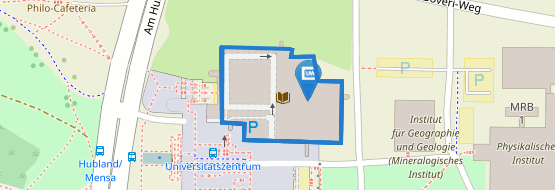History
The first, short-lived version of the University of Würzburg (1402) did not have a central university library, nor did its second incarnation when it was revived by Prince-Bishop Julius Echter in 1582. The first university library was initiated by Echter“s successor, Gottfried von Aschhausen, in 1619.
Until 1981, the "Bibliotheca Academica Godefridiana“ was housed in the Old University“s Renaissance building on Domerschulstrasse. The collection rapidly expanded following the purchase of private book collections belonging to Johann Georg von Werdenstein (canon of Augsburg), Paul Wenger (vicar of Würzburg Cathedral) and Johann Baptist Welser, a citizen of Augsburg.
The Thirty Years' War had a major impact, and its effect would not be reversed until Bishop Johann Philipp von Greiffenclau (1699–1719) introduced his prudent acquisition policy.
Johann Philipp von Greiffenclau supported the library with his own collection as well as acquiring the private collections of Johann Salentin Faust von Stromberg and Wolfgang Fabricius.
The University Library also acquired the library of the Würzburg Jesuit college following the dissolution of the order in 1773 and the private library of the progressive Prince-Bishop Franz Ludwig von Erthal.
From 1803, the confiscation of church property as compensation for lost secular powers – "secularisation" – sent a veritable flood of books to Domerschulstrasse from the former ecclesiastical principality of Würzburg, including valuable manuscripts and early printed books.
These came from many sources, including the dissolved collections of the Cathedral Library, the Haug and Neumünster collegiate foundations, and the Benedictine abbeys of St. Stephan and St. Jakob (Scots Monastery). Collections were also acquired from numerous secularised monasteries outside the city, including the Münsterschwarzach Benedictine abbey, the Cistercian abbeys in Ebrach, Bildhausen and Bronnbach, and the Carthusian monasteries in Grünau, Astheim, Ilmbach and Tückelhausen.
Only a small proportion of these enormous collections were integrated – around 10,000 volumes – while the rest were sold or stored in duplicate collections. By 1806, the collection had grown to 25,500 volumes overall.
With things becoming a little cramped, the library was forced to relocate: In 1896, the University moved to its prestigious new building on Sanderring, and the library moved into the old building on Domerschulstrasse.
By 1907, the collection had reached 370,000 volumes. This growth continued slowly through the years of the First World War and the Weimar Republic. At the last count before the destruction of Würzburg, it contained 462,000 volumes.
On 16 March 1945, most of the City of Würzburg was destroyed by an air raid. The University Library was not spared; the building was gutted by fire and 80% of the collections that had not been moved were destroyed.
The greatest disaster in the library's history, this was followed by an era of arduous rebuilding and the painstaking replacement and expansion of its book collections. The (modest) reconstruction of its rooms was not completed until 1957: at this point it had a reading room with 80 desks and a reading room for manuscripts and journals.
Following a surge in student and user numbers and literature acquisitions, the Main Library needed a new home. The new Main Library opened on the Hubland campus on 15 July 1981.
This vast facility, with architecture by Alexander Freiherr von Branca (who died on 21 March 2011, aged 91), continues to impress with its enlightened design and clear functionality. The pioneering interior architecture enables flexible and meaningful use and even now is able to accommodate progress in library technology and student numbers that have increased at twice the planned rate.
User acceptance of the building has risen enormously since 1981, and particularly in the last few years, clearly confirming Branca's architectural foresight in designing an intellectual space that, many years later, continues to fulfil evolving functions (such as a place to study).
The library is now one of the University“s central service providers. It is open to members – and, of course, to anyone from the region – more than 340 days a year.
The University Library collection (Main Library with all faculty, institute and clinic libraries) currently contains over 3.6 million items from more than two millennia, from the Egyptian Sosylos papyrus from the 2nd century BCE to 2,257 medieval manuscripts, 2,949 early modern printed books and around 8,000 current journals through to multimedia DVDs.
The building is now set to be modernised to fulfil the requirements of the coming decades.


